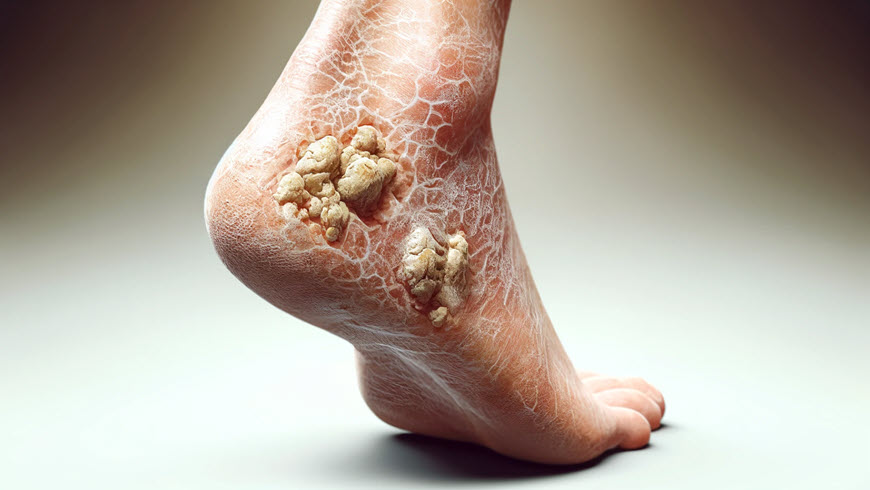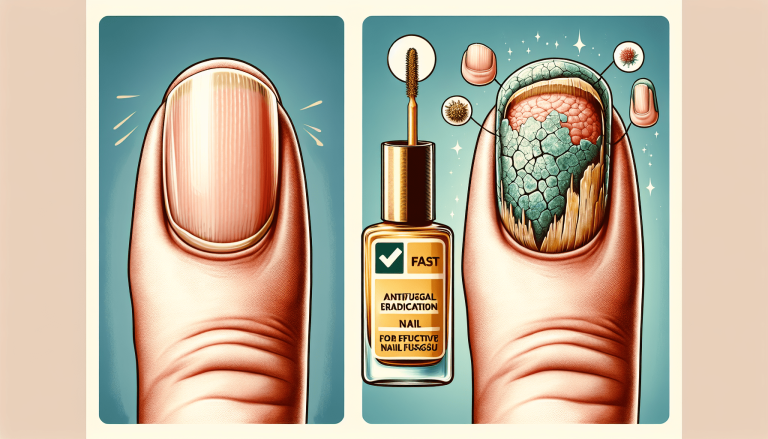What Happens If Foot Fungus Goes Untreated?
So you’ve noticed a pesky case of foot fungus, huh? Well, let’s talk about what can potentially happen if you choose to ignore it. Picture this: your feet itching, burning, and developing unsightly blisters or sores. Not only does it sound uncomfortable, but it can also lead to more serious complications if left untreated. From toenail deformities to painful skin infections, the consequences of ignoring foot fungus can be quite unpleasant. But fear not, my friend, because in this article, we’ll explore the potential risks you face and offer some helpful strategies for tackling that stubborn foot fungus head-on.

Infection spreads to other parts of the feet
If foot fungus is left untreated, there is a high risk of the infection spreading to other parts of the feet. The warm and moist environment inside shoes and socks provides the perfect breeding ground for the fungus to thrive, making it easy for the infection to spread.
Risk of spreading to toenails
One of the most common complications of untreated foot fungus is the risk of it spreading to the toenails. Fungal infections in the toenails, also known as onychomycosis, can be much more stubborn and difficult to treat compared to a simple fungal infection on the skin. It can lead to thickening, discoloration, and crumbling of the nails, causing them to become unsightly and prone to further infections.
Risk of spreading to the soles of the feet
If left untreated, foot fungus can also spread to the soles of the feet. This can result in a condition known as moccasin-type athlete’s foot, where the skin becomes dry, thickened, and scaly. It can be extremely uncomfortable and may cause cracking and peeling of the skin, leading to pain and discomfort with every step.
Risk of spreading to other skin areas
Foot fungus can easily spread to other skin areas if not treated promptly. It can extend beyond the feet and affect the ankles, legs, and even the groin area. This can lead to a more widespread and difficult-to-treat infection, causing a lot of discomfort and inconvenience. It is important to address foot fungus early on to prevent further complications.
Increased discomfort and pain
Neglecting foot fungus can result in increased discomfort and pain, making everyday activities more challenging. The initial itching and burning sensations that accompany foot fungus may worsen over time, causing constant irritation and discomfort.
Worsening of itching and burning sensations
As the foot fungus progresses, the itching and burning sensations can intensify. This can become particularly bothersome, making it difficult to focus on daily tasks or enjoy activities such as walking or exercising. The constant urge to scratch the affected areas can also disrupt sleep and lead to further skin irritation.
Development of blisters and ulcers
If foot fungus is left untreated for an extended period, it can lead to the development of blisters and ulcers on the feet. The excessive moisture and friction caused by shoes can further aggravate the condition, causing painful blisters to form. These blisters can rupture, increasing the risk of infection and making walking or standing incredibly painful.
Difficulty in walking or standing for long periods
Persistent foot fungus can significantly impact mobility and quality of life. The discomfort and pain associated with the infection can make walking or standing for long periods extremely challenging. This can affect daily activities, work productivity, and even limit social interactions, causing frustration and a decreased overall sense of well-being.
Persistent symptoms
Ignoring foot fungus can lead to the persistence of bothersome symptoms, making it difficult to find relief from the infection.
Continued presence of itchy and red skin
Untreated foot fungus can result in itchy and red skin that persists, even after attempts to alleviate symptoms. The constant itching can be highly frustrating and can lead to broken skin, leaving the feet vulnerable to further infections. The redness can also be unsightly and cause self-consciousness when wearing open-toed shoes or going barefoot.
Prolonged bad odor from the feet
Foot fungus that goes untreated can often result in a prolonged bad odor emanating from the feet. The combination of fungal growth, sweat, and bacteria can create a strong and unpleasant smell. This can be embarrassing and may lead to self-consciousness, causing individuals to avoid situations where they need to remove their shoes.
Unresolved pain and discomfort
If foot fungus is left untreated, the pain and discomfort associated with the infection may continue indefinitely. The persistent symptoms can affect the overall quality of life, causing frustration and a constant need for relief. It is crucial to seek treatment to address the underlying infection and find lasting relief from pain and discomfort.
Complications in high-risk individuals
Certain individuals, such as those with diabetes, weakened immune systems, or compromised circulation, are at a higher risk of complications if foot fungus is left untreated.
Diabetic foot complications
For individuals with diabetes, foot fungus can pose a significant risk. Diabetes can lead to poor circulation and nerve damage, making it harder for the body to fight off infections. Foot fungus left untreated in diabetic individuals can result in serious complications, including ulcers, infections, and even potential amputations.
Elderly individuals with weakened immune systems
The elderly population tends to have weaker immune systems, making them more susceptible to infections. Neglected foot fungus can lead to severe complications in this demographic, including open wounds, ulcers, and cellulitis. Prompt treatment is essential to prevent the progression of infection and safeguard the overall health of elderly individuals.
Individuals with compromised circulation
Poor circulation can hinder the body’s ability to effectively combat infections. Individuals with compromised circulation, such as those with peripheral artery disease or venous insufficiency, may experience delayed healing and increased risk of infections. If foot fungus is left untreated in these individuals, it can quickly escalate into serious complications and impact their overall well-being.

Secondary bacterial or fungal infections
Neglecting foot fungus increases the risk of developing secondary bacterial or fungal infections, adding to the overall burden on the feet and making treatment more complex.
Risk of bacterial infection
Foot fungus weakens the skin’s natural defense mechanisms, making it more susceptible to bacterial infections. If left untreated, the fungal infection can create open sores or breaks in the skin, providing an entry point for bacteria. Bacterial infections can cause pain, inflammation, and even systemic symptoms, requiring aggressive medical intervention.
Risk of cellulitis
Cellulitis is a potentially serious bacterial infection that can occur when foot fungus progresses and breaks down the skin’s protective barrier. It can lead to redness, swelling, pain, and warmth in the affected area. If cellulitis is left untreated, the infection can spread rapidly and affect deeper tissues, potentially leading to blood infections or sepsis.
Risk of athlete’s foot becoming a chronic condition
Failure to address foot fungus in a timely manner can result in chronic athlete’s foot. Chronic athlete’s foot is characterized by the persistent recurrence of symptoms, even after treatment attempts. It can become a frustrating and challenging condition to manage, often requiring long-term treatment and ongoing preventative measures.
Psychological and social impact
Untreated foot fungus can have a significant impact on an individual’s psychological well-being and social interactions, affecting their overall quality of life.
Decreased self-esteem and confidence
Persistent foot fungus can erode self-esteem and confidence in individuals. The visible symptoms, such as redness, itching, odor, and changes in nail appearance, can be embarrassing and make individuals feel self-conscious. This can result in a negative self-perception and impact their overall confidence and well-being.

Embarrassment and social isolation
Foot fungus that goes untreated can lead to feelings of embarrassment and self-consciousness, causing individuals to withdraw and limit their social interactions. The fear of judgment or discomfort due to the appearance or odor of their feet can lead to social isolation and a decreased sense of connection with others. It is essential to address foot fungus promptly to prevent these negative social and emotional consequences.
Impact on personal and professional relationships
Neglected foot fungus can also impact personal and professional relationships. The discomfort and pain associated with the infection may limit activities with loved ones or interfere with work performance. Individuals may find it challenging to participate in activities that require removing shoes or exposing their feet, causing them to miss out on meaningful connections and experiences.
Delayed or ineffective treatment
If foot fungus is left untreated, it can result in the need for more aggressive treatment methods, a longer recovery time, and an increased risk of treatment failure.
Longer recovery time
The longer foot fungus is left untreated, the longer the recovery time may be. In some cases, the infection can become deeply entrenched, requiring extended treatment periods involving multiple medications and therapies. Prompt intervention is crucial to minimize the recovery time and expedite the healing process.
Requirement for aggressive treatment methods
Neglecting foot fungus can lead to the need for more aggressive treatment methods to combat the infection. Topical antifungal medications may no longer be effective, and oral antifungal medications or even injections may be required. These aggressive treatments can come with more potential side effects and require closer monitoring by healthcare professionals.
Higher risk of treatment failure
As foot fungus progresses and becomes more resistant to treatment, the risk of treatment failure increases. This can lead to prolonged frustration and discomfort, with individuals struggling to find an effective solution. Seeking timely treatment can improve the likelihood of successful treatment outcomes and minimize the risk of treatment failure.
Spreading to others
Untreated foot fungus can not only impact the individual but also pose a risk of spreading the infection to others, amplifying the consequences.
Risk of infecting family members
Foot fungus is highly contagious, and leaving it untreated increases the likelihood of infecting family members. Close contact within households, such as sharing towels, walking barefoot on the same surfaces, or using common shower areas, can facilitate the transmission of the fungus. It is crucial to seek treatment promptly to prevent the infection from spreading to others.
Increased likelihood of transmission to close contacts
Neglecting foot fungus can also lead to increased transmission to close contacts outside of the household. Activities such as participating in sports, using communal showers or locker rooms, or borrowing shoes can create opportunities for the fungus to spread. It is important to address foot fungus to minimize the risk of infecting others and prevent the establishment of a larger outbreak.
Potential for outbreak in communal settings
Foot fungus left untreated in communal settings, such as gyms or swimming pools, can potentially lead to outbreaks. The warm and damp environment facilitates the spread of the fungus, and individuals unknowingly walking around with untreated foot fungus can contaminate surfaces and endanger the health of others. Prompt treatment and good hygiene practices are essential in preventing outbreaks in communal settings.
Chronic and recurring foot fungus
If foot fungus is not effectively treated, it can become chronic and recurrent, causing ongoing frustration and discomfort.
Difficulty in eradicating the infection
Neglected foot fungus can become deeply entrenched and challenging to eradicate completely. The fungus may have spread to multiple areas and become more resistant to treatment methods. Treating chronic foot fungus often requires a comprehensive approach, involving the use of multiple antifungal treatments, lifestyle modifications, and diligent hygiene practices.
Frequent reoccurrence of symptoms
Untreated foot fungus can often lead to frequent reoccurrence of symptoms. Even after successful treatment, the fungal infection can resurface, causing frustration and a constant need for ongoing management. It is important for individuals with chronic foot fungus to be diligent in their foot care routine and seek medical attention as soon as symptoms reappear to prevent further complications.

Need for ongoing treatment and management
Chronic foot fungus typically requires ongoing treatment and long-term management. This may involve regular use of antifungal medications, diligent foot hygiene practices, and lifestyle modifications. Prevention strategies, such as regularly changing socks, using antifungal powders, and avoiding moist or tight-fitting shoes, are crucial in managing chronic foot fungus and preventing future flare-ups.
Damage to the nails and skin
Untreated foot fungus can lead to damage to the nails and skin, causing further complications and aesthetic concerns.
Thickening and discoloration of nails
If foot fungus spreads to the toenails, it can lead to thickening and discoloration of the nails. The infected nails may become yellow, brown, or even black. The thickness and change in appearance can be unsightly and may cause individuals to feel self-conscious about exposing their feet or wearing open-toed shoes.
Separation of the nail from the nail bed
Untreated foot fungus can cause the nail to separate from the nail bed, a condition known as onycholysis. This can result in pain, tenderness, and an increased risk of developing additional infections. Separation of the nail from the nail bed can also make it difficult to apply topical medications, hindering the effectiveness of treatment efforts.
Weakening and cracking of the skin
Foot fungus can lead to weakening and cracking of the skin, especially in areas where the infection is severe. The cracks in the skin provide entry points for bacteria and create the potential for painful complications such as ulcers or cellulitis. Prompt treatment is necessary to prevent further damage to the skin and minimize the risk of additional infections.
In conclusion, neglecting foot fungus can have numerous consequences. From the spread of infection to other parts of the feet and the risk of secondary infections to increased discomfort, pain, and complications in high-risk individuals, the impact is wide-ranging. Additionally, there can be psychological and social consequences, delayed or ineffective treatment, increased risk of spreading the infection to others, and the development of chronic and recurring foot fungus. It is essential to seek prompt treatment for foot fungus to prevent these complications and ensure the overall health and well-being of individuals.
Additional Resources

Have you been using this popular fungus treatment in the last 6 months?
You need to stop immediately! Because Scientists at the Infectious Disease Society of America just made a shocking discovery…
After running hundreds of tests on people with foot fungus… They discovered that the infection is caused by this very treatment.
85% of people suffering from fungus use it at least once. The amazing part is, after removing it from their routines, patients cleared nail fungus for good…
Re-growing their nails and rejuvenating their skin… Without using any toxic creams or pills in the process.






